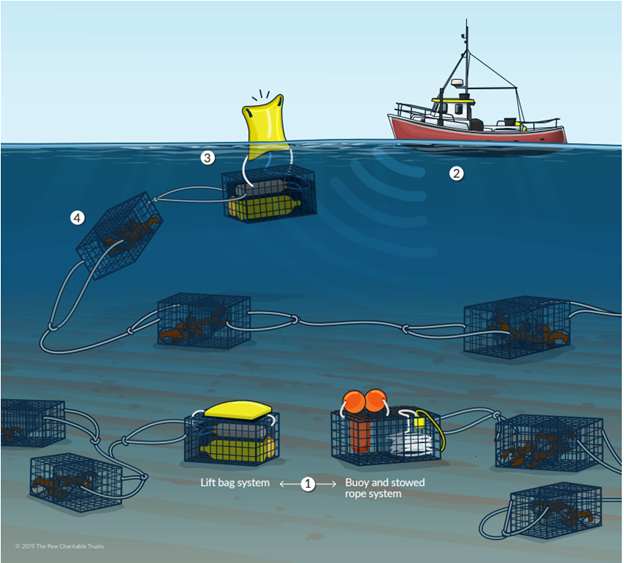In this episode of Maine Coast Dock Talk, host Ben Martens interviews Noah Oppenheim of Homarus Strategies on a report commissioned by the Massachusetts Division of Marine Fisheries he authored titled "Assessing the Feasibility of On-Demand Gear in New England Lobster Fisheries."
You can listen to the podcast on our website, or find "Maine Coast Dock Talk" wherever you listen.
You can download the full report with the following link.
North Atlantic right whales are critically endangered and protected in the U.S. under the Marine Mammal Protection Act and the Endangered Species Act. The Atlantic Large Whale Take Reduction Team was tasked with the goal of reducing incidental mortality of large whales in commercial gillnet and trap/pot fisheries. In 2021, new regulations were passed to reduce the risk to right whales from fishing gear entanglement. This included a ten-year plan that requires the Maine lobster industry to reduce risk to right whales by 98%.
"In 2021, the federal government adopted a draconian 10 year plan intended to protect North Atlantic right whales. The plan will not protect right whales, but it will eliminate the Maine Lobster fishery. The plan requires three phases of risk reduction for the Maine lobster industry to achieve a 98% by 2030. If lobstermen do not meet this mandate, it will be illegal for the federal government to continue to permit the lobster fishery. Maine lobstermen implemented the phase 1 reductions in May 2022."
-Maine Lobstermen's Association
"Currently, the only way to significantly reduce the risk of entanglement is to close an area to fishing when right whales are predicted to be there. But these closures come at a cost to lobstermen who cannot easily move their traps to other locations. Ropeless fishing offers an alternative that could recover right whales and preserve the livelihood of New England’s iconic lobstermen and women."
-Conservation Law Foundation
In the risk assessment equation used by the Take Reduction Team, rope in the water represents risk to right whales. Each buoy line represents a certain percentage of risk, regardless of if it is attached to a trap, gillnet, or aquaculture gear. In order to reduce risk, some rope can be made weaker, so that it breaks if a whale hits it, but using the current risk assessment model, to hit the 98% risk reduction goal, rope must be removed from the ocean. Ropeless systems have the capacity to reduce the amount of line in the water without requiring closed areas.
In an on-deamand system, the line between the buoy at the water’s surface and the trap at the bottom is removed and a “ropeless” system is used instead. The three main proposed systems all include a signal that must be sent from the boat in order to deploy the method to cause the trap to resurface. There are also some systems that use a timer to release the buoy at a prescribed time, but those have not yet been tested in New England.

photo credit: Pew Charitable Trusts
In 2021, the Massachusetts Division of Marine Fisheries (DMF), in partnership with Homarus Strategies, began a one-year investigation into the issues and conflicts surrounding the integration of on-call fishing gear technology in New England. The project was funded by the National Fish and Wildlife Service and the National Oceanic and Atmospheric Administration and was centered around interviews with experts to gain additional insight into the perceptions of the new regulations by a diverse group representing the fisheries industry, including fisheries stakeholders, scientists, conservation organizations, and economists.
The report, Assessing the Feasibility of On-Demand Gear in New England Lobster Fisheries, was released in April 2022 and includes information gleaned from over 130 hours of interviews, as well as during a two-day workshop. The publication of the report is only the first phase of the project, with the second phase occurring now in 2022 centering on the socio-economic issues of ropeless gear to develop a model for cost impact estimates for lobster fisheries affected by the new regulations.
Read more about ropeless gear here: https://www.fisheries.noaa.gov/new-england-mid-atlantic/science-data/protected-species-gear-research
Read more about the Atlantic Large Whale Take Reduction Plan here: https://www.fisheries.noaa.gov/new-england-mid-atlantic/marine-mammal-protection/atlantic-large-whale-take-reduction-plan


Comments